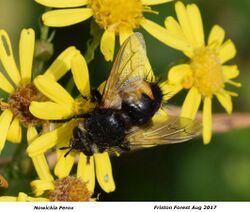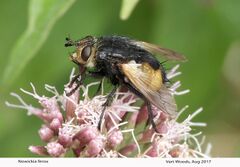Biology:Nowickia ferox
| Nowickia ferox | |
|---|---|

| |
| Tachinid fly, Nowickia ferox, dorsal view | |
| Scientific classification | |
| Domain: | Eukaryota |
| Kingdom: | Animalia |
| Phylum: | Arthropoda |
| Class: | Insecta |
| Order: | Diptera |
| Family: | Tachinidae |
| Tribe: | Tachinini |
| Genus: | Tachina |
| Subgenus: | Nowickia |
| Species: | N. ferox
|
| Binomial name | |
| Nowickia ferox (Panzer, 1809)
| |
| Synonyms | |
| |
Nowickia ferox is a species of fly in the family Tachinidae first described by Georg Wolfgang Franz Panzer in 1809.[1][2]
Distribution and habitat
This species is present in most of Europe.[3] These flies mainly inhabit spruce forest edge, meadows, areas of heath and mountains at an elevation up to 1,500 metres (4,900 ft) above sea level.[4][5]
Description
Nowickia ferox can reach a length of 11–15 millimetres (0.43–0.59 in).[4] These flies have a black hairy thorax and a yellow-red abdomen, with a black longitudinal marking in the middle and numerous long straight bristles at the end. Wings are hyaline (glass like), yellowish at the base.[6] Basal half of the palps are brown or blackish. Males are a little concave in theirs dorsal centre. In the abdomen only segments 7 and 8 are hairy.[5]
Biology
Nowickia ferox is a univoltine species. Adults can be found from mid-June to October, with a peak from June to August. They fed on nectar and pollen, especially of Centaurea jacea.[4] Larvae develop in the dark arches moth (Apamea monoglypha).[4][5][6]
References
- ↑ BioLib.cz
- ↑ Bisby F.A., Roskov Y.R., Orrell T.M., Nicolson D., Paglinawan L.E., Bailly N., Kirk P.M., Bourgoin T., Baillargeon G., Ouvrard D. Catalogue of Life
- ↑ Fauna Europaea
- ↑ 4.0 4.1 4.2 4.3 Commanster
- ↑ 5.0 5.1 5.2 Hans-Peter Tschorsnig and Benno Herting The Tachinids (Diptera: Tachinidae) of Central Europe: Identification Keys for the Species and Data on Distribution and Ecology. State Museum of Natural Science, Stuttgart
- ↑ 6.0 6.1 Nature Spot
External links
Wikidata ☰ Q14391765 entry


